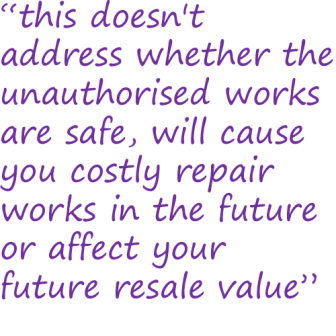How to Get a Building Control Regularisation Certificate
- Buying a property that has been built without planning permission and/or building control sign off can prevent you from continuing with your purchase.
- This can be resolved with a Building Control Regularisation Certificate, or in some cases, indemnity insurance.
- Absent building regulations approval can be an innocent oversight or an indication that the works are unsafe and could pose serious risk to the safety of the building and its occupants
- Our article Building Control Sign Off Explained, covers what types of building work require council sign off.
What can you do if you are buying a property with no building control sign off?
Whether it be a single storey rear extension or a loft conversion, there are a number of issues that could lay hidden underneath the walls and floors. What normally happens during building works are regular sign-offs for the building work undertaken including the electrics, insulation, windows and room sizes.
The challenge is that checking these building works after the work has been completed will require an intrusive inspection; in some cases in can be as bad as to pull the whole thing down and start again.
Mortgage lenders generally do not see property with unauthorised works as adequate security for their loan so you must resolve the issue, one way or the other.
The options available to a buyer are:
- 1
Regularisation certificate
Building regulations regularisation allows unauthorised work to be certified by Building Control, confirming is it in line with the relevant legal and regulatory requirements.
Where unauthorised work has been carried out by the seller, with no notice given nor plans submitted, an application can be made to Building Control for a Certificate of Regularisation (also called a letter of regularisation).
Building control regularisation applications can be made for both domestic and non-domestic works commenced on or after 11th November 1985. Building work that has been completed prior to this date is not covered by the Regularisation procedure, as it pre-exists modern building regulations.
The risk of going straight to the local authority for the certificate of regularisation is if the works are found to be non-compliant. Once the council are aware than the works are non-compliant, the option of insurance is off the table. The lender may withdraw or reduce the mortgage offer and the seller may be left having to remedy the works before sale, or sell at a reduced price to buyer with a willing lender, or begin the process again to find another cash buyer.
Even if the work is compliant, buyers and sellers alike may be reluctant to wait for the council, who can take weeks to send out a building control inspector.
- 2
Building Regulations Indemnity Insurance

The most common solution is to obtain indemnity insurance to protect against the removal of the unauthorised works and this normally satisfies the mortgage lender. However, this isn't recommended as it offers no assurances that the unauthorised works are safe, will cause you costly repair works, or affect your future resale value.
You cannot get indemnity insurance if the local authority is already aware of the unauthorised works.
The best advice is to get the unauthorised works signed off by Building Control before you take legal ownership of the property (and take on the burden of addressing the unauthorised work in the future) - although getting a letter of regularisation can take a number of weeks.
What is the best solution to building control regularisation?
If you're considering both of these options and thinking neither seem adequate, you're not wrong! Indemnity insurance doesn't adequately protect the buyer (only their lender). Often the seller will refuse to allow the buyer to notify the council, as the risk of the work being non-compliant is too great.
We recommend a third way which offers a win-win to both parties:
Qualifying assessment from a structural engineer
With the owner's consent, our structural engineer will conduct an intrusive inspection of the property to:
- 1confirm that the works appear compliant and simply need to be signed off by building control;
- 2outline any works required to make the work structurally compliant before bringing a building control inspector in to grant the letter of regularisation certificate; or
- 3confirm that the work would need to be completely undone or redone to meet building regulations.
Depending on the results, you still have the option of either insurance or regularisation. The local authority are none the wiser, and both the buyer and the seller have a reliable assessment on which to move forward.
- If the work is compliant or requires minimal work that the owner can correct before sale, then you can contact your local authority for an inspection and letter of regularisation certificate.
- If the work is non compliant, you can opt for indemnity insurance and negotiate for a reasonable reduction in price.
- If the buyer pulls out, the seller can find another buyer who is willing to purchase with indemnity insurance.
Structural Engineers | Fixed Fees | Same week availability | Access arranged
In addition to Part A of the building regulations (structure), some building control requirements, such as fire safety and escape routes, fall under the remit of a home surveyor. You may also need to instruct a surveyor for a complete appraisal.
Andrew started his career in 2000 working within conveyancing solicitor firms and grew hands-on knowledge of a wide variety of conveyancing challenges and solutions. After helping in excess of 50,000 clients in his career, he uses all this experience within his article writing for SAM, mainstream media and his self published book How to Buy a House Without Killing Anyone.
Caragh is an excellent writer and copy editor of books, news articles and editorials. She has written extensively for SAM for a variety of conveyancing, survey, property law and mortgage-related articles.









